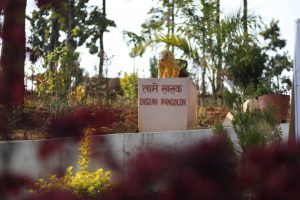Displaced from their homes again and again as the Sharda River erodes its banks, many residents of Puranpur sub-division in Pilibhit district of Uttar Pradesh now have no option but to live in shanties they have set up on roadsides and atop embankments.
The transboundary Sharda River – called the Mahakali in Nepal – has been changing course repeatedly over the last two decades, submerging farmland and forests in this forgotten corner near the India-Nepal border. All that the government has been doing is to dredge the riverbed and build more embankments that keep breaking down.
“We lost our agricultural land and are now forced to do small daily wage works for Rs 100-150 for survival.”Phul Mohammad
Many of those displaced are descendants of those who moved from what is now Bangladesh, the first wave when India was partitioned in 1947, and subsequently till the 1960s. Others moved from different parts of eastern Uttar Pradesh under a special resettlement scheme – some from the Khiri area right on the Nepal border, and some from villages around the city of Gorakhpur.
All those who had moved in the hope of a new life are now forced to move again and again, as the Sharda swallows up their farmlands and homesteads.
![The river eating away the land at the edge of Chandiya Hazra village [image by: Manoj Singh]](https://dialogue.earth/content/uploads/2020/02/चंदिया-हजारा-गांव-के-पास-शारदा-नदी-कटान-करते-हुए.jpg)
Thanks to dams and barrages upstream and downstream, in the eight non-monsoon months of the year water flow in the Sharda is too weak to flush away silt. In its 40-kilometre stretch through Pilibhit district, the maximum depth of the river is now 12 metres, as the silt keeps accumulating. Little wonder that the river floods every year as soon as it is swelled by the monsoon rains.
The effect is now on more than farms and forests and village homes. Riverside slums of Rahul Nagar – located in Chandiya Hazra village panchayat of Puranpur sub-division – were ruined last year. The residents have been forced to put up shanties in a protected forest.
Sriram Dayal, a resident of Rahul Nagar, said that the river changed its course and eroded two kilometres near Dhanhara Ghat, endangering the entire area.
Rahul Nagar is a resettlement area for landless labourers. It was started in 1974, with local village chief Allaudin Shastri making special efforts to establish it. Shastri did his degree in Sanskrit, whose texts are called “shastra”, and he took his last name in reference to that; he is now 86. He told thethirdpole.net that the Sharda had “ruined” 20 villages in the last two decades. In Rahul Nagar, the erosion started in 1994, and has accelerated since.
Seventy-year-old Sampat said, “I originally lived in old Rahul Nagar, but had to shift after the river changed its course. I got 2.5 acres of land when I shifted, but that has also been submerged in the river. Now I have no place to go.”
![The labourers who live in Rahul Nagar [image by: Manoj Singh]](https://dialogue.earth/content/uploads/2020/02/राहुल-नगर-मजदूर-बस्ती-के-किसान.jpg)
Phul Mohammad, 50, another resident of Rahul Nagar, said, “We shifted to these slums, but here also we are going through the same problem of erosion due to the river. We lost our agricultural land and are now forced to do small daily wage works for Rs 100-150 for survival. We were not required to buy grains earlier, but now we need to buy. If erosion continues, our village will vanish and we will be on the road.”
Munni Devi, 50, has been petitioning the authorities to build an embankment to save Rahul Nagar, but to no avail. “We had two acres of agricultural land,” she told thethirdpole.net. “We grew turmeric on half an acre and sugarcane on one and a half acres. Everything is now lost to the river. No one earns in the family. My husband has already passed away. I have two sons and two daughters. I took a loan of INR 150,000 (USD 2,090) for the marriage of my daughter. I lost my main source of income, my agricultural land. How will I repay the debt and how will I take care of the family? The way the river is submerging our village, I don’t think the village will survive. Where will we go?”
Shahnawaz Ansari of Rahul Nagar points to a spot in the river and says, “That was my home, and 2.5 acre of agricultural land, until six months ago. Everything was submerged in front of my eyes. I am now homeless and landless. I have got a small piece of land in the middle of the village to stay. My father has gone out of the village to earn; we have not received any compensation from the government. My two younger brothers and I have no option but to work as labourers.”
“How will I educate my children?” wonders another displaced resident, Manbhavti. “Officials came when erosion was happening, they tried to stop it. Everyone in the village worked with them. We even cooked meals for them. They said, they will come again, but never returned.”
![There used to be a paved road here, but two kilometres of it disappeared with the river [image by: Manoj Singh]](https://dialogue.earth/content/uploads/2020/02/यहाँ-कभी-पक्की-सड़क-हुआ-करती-थी.-नदी-की-कटान-में-दो-किलोमीटर-सड़क-गायब-हो-गयी.jpg)
The list of those who have lost their land and homes is long. People are now migrating out of the area in search of work. The number of families staying in Rahul Nagar has come down from 565 to 365 in the last 20 years or so. While many are working in other parts of Uttar Pradesh, some have moved as far as Karnataka.
Rahul Nagar is not the only devastated area. According to Uttar Pradesh government figures, there are 46 villages in Puranpur sub-division which suffer from floods in the Sharda. Of these 22 are severely impacted.
But the actual number of villages suffering from erosion is far higher than what the government figures show, according to residents.
A local college named after former Prime Minister Lal Bahadur Shastri has had to shift twice. The police station in the small town of Hazra has had to shift as well.
The effects of the Sharda changing course can be seen in many ways. There was a pontoon bridge at Dhanhara Ghat that is now useless, because the river has moved. Now a second pontoon bridge has been built. Another bridge built to connect Sidh Nagar and Hazra over what used to be the course of the Sharda now lies useless.
![Bridges become useless as the river changes its course [image by: Manoj Singh]](https://dialogue.earth/content/uploads/2020/02/धनहरा-घाट-जहाँ-कभी-शारदा-नदी-का-मुख्य-धारा-थी.jpg)
Refugees many times over
Many refugees from what was then East Pakistan and is now Bangladesh were settled in Naujalha Nakatiya village on the India-Nepal border. This village has been facing the same erosion problem for the last six years.
Resident Praful Sheel, 50, said, “The river washed away 1.5 acres of my farm. I am now left with three acres and it has become very tough to survive. An embankment was built three years ago, it has helped a bit. The flow of water has decreased. The river was small but very deep earlier; it has become shallower now but has spread a lot. If you go and see near Nangalia, the river flows in two different directions.”
Another resident, Narayan Chaudhary, points out, “The government settled us here, but the problem of soil erosion due to the river is now ruining everything. One of the colonies with 60 houses is completely ruined. People who were displaced started staying near the forest, but now the forest department is removing them from there also. People have been sent notices. Some are facing [legal] cases.”
![Narayan Chaudhary, points out, “The government settled us here, but the problem of soil erosion due to the river is now ruining everything." [image by: Manoj Singh]](https://dialogue.earth/content/uploads/2020/02/नारायण-चौधरी.jpg)
“A two-and-a-half kilometre long embankment was built from the Nepal border to Naujalha,” says former village chief Vimal Goldar. “This was the first embankment in Pilibhit district. There was a village around 250 metres from the embankment, it was washed away. There were 45 families in that village. After losing everything to the river’s course, some of them shifted to Udham Singh Nagar and some to Ramkot. There were a few who settled nearby also. The river is now moving towards the west.”
In Ramnagar, another village where the refugees were settled, the school, gurdwara, sugarcane collection centre, brick kiln and hundreds of acres of agricultural land were lost to the Sharda in 1999. Around 500 families were impacted, but nobody received any compensation from the government.
Why does the Sharda change course?
Local farmers are of the view that the Sharda keeps changing course due to deposit of silt and obstructions to its natural flow. Engineers working with the Uttar Pradesh government call it a natural process. Independent hydrologists blame both, and point out that when an embankment is built to protect one area, the water is diverted and inundates another.
Shailesh Kumar, an engineer working in Pilibhit flood division of the state government, said, “To stop the problem of erosion due to the river, we are undertaking dredging work near Chandiya Hazra. It is an experiment. We will remove the silt by dredging where it is in excess and an attempt will be made to change the course of the river. Once done, we will study the impact.”
![Alauddin Shastri had advised against early plans, and been ignored [image by: Manoj Singh]](https://dialogue.earth/content/uploads/2020/02/अलाउद्दीन-शास्त्री.jpg)
Allaudin Shastri said the Sharda started changing course when very high embankments were built for roads and bridges, thus obstructing the natural flow of the river. “I was then a member of the district level committee which looked after the 20-point programme. I opposed the decision to make the road at such a height, and said that it would affect the natural course of the river. But the engineers turned down my point saying my argument was technically wrong. Before the road and the bridge were built, river water used to reach my house in Sidh Nagar, but receded within 24 hours. But after the road and bridge, the expanse of the river decreased and this led to the devastation. When the natural course of river was obstructed it started eroding the land.” Independent hydrologists agree with Shastri rather than the engineers.
Rivers that start in the Himalayas are braided rivers that do keep changing their courses. It is now recognised that allowing the river to do so is far less harmful than trying to straitjacket a river by building embankments. In its natural meanderings, a river does flood, but it is a relatively small flood, and the waters recede soon, leaving rich fertile silt behind. When a river is straitjacketed, this silt gets deposited in the riverbed, the river gets shallower, and when it rains hard the result is far more serious flood and erosion.
![<p>The women of Rahul Nagar live in concern of the impact of the river eating up the lands [image by: Manoj Singh]</p>](https://dialogue.earth/content/uploads/2020/02/नदी-की-कटान-से-प्रभावित-राहुल-नगर-की-महिलाएं.jpg)



![Snow and rain in April 2016 was disastrous for Gilgit-Baltistan [image courtesy Pamir Times]](https://dialogue.earth/content/uploads/2016/04/snow-picture-Credit-to-PAMIR-Times-300x169.jpg)


